Kenai River Fish Count Guide
Why Count the Fish on the Kenai River?
Managing salmon numbers in Alaska’s most popular salmon fishery is serious business. Fish counts are intricately connected to where we fish, what we can fish for, what we can keep – and that’s just in the river. In season fish counts not only dictate sportfish regulations, they are also used to regulate the commercial fishing that occurs in salt water just outside of the river mouths. Essentially everything that happens season wide, both in the sport fisheries in freshwater, and commercial fisheries in the salt water, is directly connected to the actual numbers of fish returning to the river. For an Alaska fishing guide, determining the Kenai River fish count is essential for a properly maintaining the river and its fish populations for Alaska salmon fishing and more.

 How Are Kenai River Fish Counted?
How Are Kenai River Fish Counted?
Counting salmon is an age-old conundrum for fisheries managers in Alaska, who are tasked with making critical decisions that not only affect the future sustainability of salmon stocks but also allocative decisions that have substantial monetary affects on user groups that depend on salmon for their livelihoods. Further complicating this delicate balance is the fact that managers are responsible for counting and protecting not just one species of salmon but several – in many instances, multiple species at once, sometimes referred to as mixed stock fisheries. In addition to counting multiple species of salmon at the same time, counting salmon is further complicated by the different rivers they return to spawn in.
Some rivers are gin clear making visual counting by humans feasible. These rivers are often altered in strategic locations with the use of a weir to condense the fish and make them easier to see

and enumerate. This is not always an option in rivers that are glacier or turbid as you cannot see the fish. This is the case on both the Kenai and the Kasilof, where sophisticated sonar technology is used to count returning salmon. The Kenai has two different sonar stations, one at mile 14 that enumerates king salmon and another at mile 19 that counts sockeye. The Kasilof has a single sonar site at mile 8 that primarily records sockeye. Both stations record ten minutes of every hour while in operation, and extrapolate the total daily counts based on these numbers.
What is Escapement?
Escapement is a term fishery managers use to identify the number of fish needed to successfully spawn and sustain the run within healthy historical numbers. This escapement goal number is different for each species and river, and is carefully established by the Alaska Board of Fisheries. The escapement numbers and goals are woven into a complex management plan for each river system, with specific directives for each species and specific dates where certain numbers must be achieved to avoid potential restrictions and even closures. Conversely, if a run is overly abundant and exceeds the upper end of the escapement numbers, managers can liberalize or increase limits to encourage additional harvest. In the world of salmon, everything revolves around escapement numbers and having real time, accurate methods for counting fish becomes paramount to responsible management.
For more information on the many different fish counts that occur annually throughout the state of Alaska please visit the Alaska Dept. of Fish & Game.
Are you interested in Kenai River fishing? We offer the best guided fishing trips in Alaska – book your fishing trip today!
